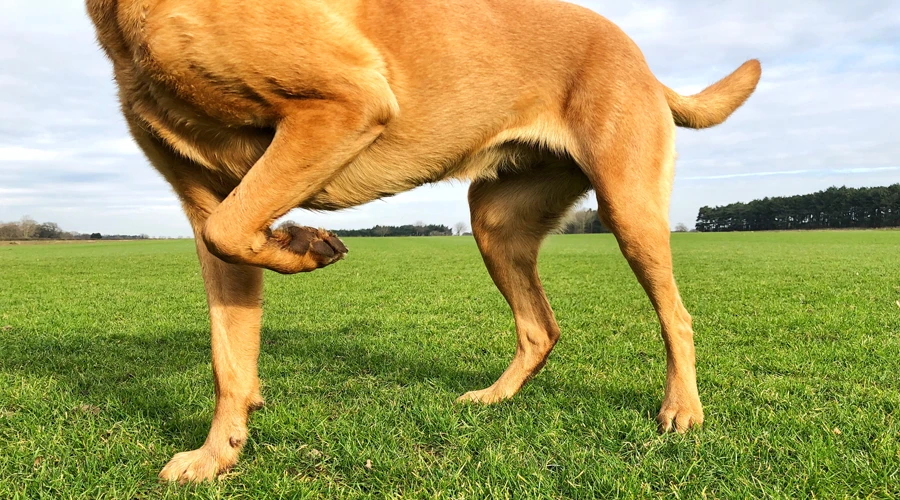In dog arthritis, sooner is better for your dog’s long-term quality of life
While arthritis in dogs used to be considered a disease mainly caused by wear and tear on the joints of older dogs, it’s now proven to be a disease that starts very early on. In fact, in 1 study, early arthritis could be seen on X-rays of dogs less than 4 years old, and 60% of those dogs were already showing the initial signs of the disease. See the study here.
Early detection and treatment are key to managing the pain and progression of dog arthritis effectively. This blog answers questions about the signs and symptoms of early dog arthritis, the consequences of leaving it untreated, the best time to begin treatment, and how a breakthrough approach, called Synovetin OA®, is set to change the game in canine joint health.
What is dog arthritis?
Dog arthritis is a disease of ongoing inflammation inside the joint. Arthritis literally means “joint inflammation.” This inflammation not only causes the pain of arthritis; it also causes the cartilage that cushions the joint to break down over time. This can really take a toll on a dog’s quality of life, as the debilitating pain of this disease slows them down and robs them of their joyful mobility. Once cartilage starts eroding, it can’t be stopped. That’s why it’s so important to treat the inflammation as soon as possible.
What are the early signs to look for in dog arthritis?
Recognizing arthritis early on is critical to protecting your dog’s long-term quality of life. While the signs can be subtle at first because dogs are so good at “hiding” pain, here are 5 early symptoms you should watch for:
- Walking in a stilted or uneven manner, especially after rest following a day of vigorous play. Changes in the way your dog moves could be an early sign. It might look like a slight limp, or it might be more subtle, like your dog is “walking funny” or standing in a new and different way.
- Hesitation to fully engage in activities he or she enjoys. Instead of bolting out across the yard at high speed and jumping for balls, you might notice your dog has started loping at an easy pace rather than running or waiting for a ball to drop to the ground instead of leaping for it.
- Stiffness, especially in the morning or after a long nap. Stiffness is a telltale sign. Dogs with early arthritis may start walking with a shorter stride, appear slower than they used to, or walk unevenly.
- Lacking enthusiasm or lagging behind on walks. Dogs with early arthritis may seem less excited to go on walks. They may prefer to move at a slower pace, want to rest a bit more, or seem more tired than usual when you get home.
- Licking or chewing on joints. Some dogs will begin excessively grooming a joint that is hurting, like licking or even chewing on the area.
What happens if dog arthritis is not addressed early?
Ignoring the early signs of arthritis can lead to significant and even irreversible damage to the joint as the cartilage breaks down and the bones begin to rub together painfully. Here’s what may happen if arthritis progresses without treatment:
- Chronic pain. What starts as occasional discomfort can become constant, unrelenting pain for your dog
- Severe mobility loss. Advanced arthritis can render dogs unable to stand, walk, or perform basic activities without assistance
- Injuries. Dogs may strain other parts of their body while favoring an arthritic limb, leading to injuries like ligament strains, tendinitis, and spinal problems
- Reduced quality of life. Pain and inactivity can lead to depression, weight gain, loss of interest in engaging with other pets or family, even lack of appetite
- Shortened lifespan. Although arthritis itself is not fatal, the complications it causes have the potential to reduce a dog’s overall lifespan and well-being
When should I talk to my vet about my dog’s symptoms?
It’s important to talk with your veterinarian at the very first signs of dog arthritis even if your dog is still very young. Starting treatment as soon as symptoms appear will give your dog the best chance at enjoying many joyful, play-filled years ahead. And, in the case of breeds that are prone to developing arthritis, like Labradors, Golden Retrievers, German Shepherds, and Rottweilers, consulting with your vet even before you are sure of the signs could make all the difference.
Your veterinarian may suggest strategies like weight management and physical therapy. He or she may also want to begin treatment with pain relievers and joint supplements. And, more and more often, veterinarians are looking to begin treatment in early dog arthritis with newer advances, like Synovetin OA.
What makes Synovetin OA a good choice for treating early dog arthritis?
Synovetin OA is a completely different kind of arthritis treatment. It doesn’t mask pain signals like most pain drugs do. It actually acts on what causes the pain and progression in the first place—inflammation. That means dogs move more comfortably today and get pain relief that lasts up to 1 full year with just 1 treatment. They also benefit from Synovetin OA’s potential to prevent future pain by targeting the inflammation that results in cartilage erosion over time.
Synovetin OA is given by a simple, one-time injection into the affected joint that takes just minutes. Once inside the joint, it goes to work to provide:
- Relief exactly where it’s needed—and only where it’s needed. Synovetin OA works by delivering targeted microscopic medical particles (called tin-117m) to deactivate and remove the damaging cells that cause inflammation, pain, and cartilage erosion
- Long-lasting pain relief. Just 1 injection can provide up to 12 months of relief
- The potential to slow arthritis progression. Research in rats showed that tin-117m actually interrupted the progression of arthritis joint damage. Clinical trials in dogs with elbow arthritis treated with Synovetin OA provide evidence that a similar process might be at work. These dogs experienced up to 1 year of continual pain relief and joint improvement even after nearly all of the tin-117m particles had become inactive in the joint
- Exceptionally safe with no systemic side effects. Synovetin OA works only inside the joint, so it doesn’t affect a dog’s stomach, liver, or kidneys. In extensive safety studies and real-world use by 100s of veterinarians around the country, Synovetin OA has been found very safe. It’s now been used in 1000s of dogs with no significant systemic side effects
Is Synovetin OA right for my dog?
Dog arthritis is a serious condition that deserves prompt attention and early signs should never be ignored. With early treatment, including innovative options like Synovetin OA, it’s possible to maintain your dog’s mobility, reduce their pain, and extend their happy activity well into older age.
If you suspect your dog is developing arthritis, schedule a veterinary exam as soon as possible. Be sure to discuss all of the treatment options and ask if Synovetin OA might be the key to giving your dog a more comfortable, mobile future.
Curious if Synovetin OA is a good treatment for your dog? Other pet parents have seen amazing success that transformed their dogs’ lives. See them here.
Want to know what veterinarians have to say about Synovetin OA? Watch vets from around the country share their own experiences. See them here.
Ready to talk to a veterinarian about Synovetin OA? Find a treatment center near you using this locator map.




